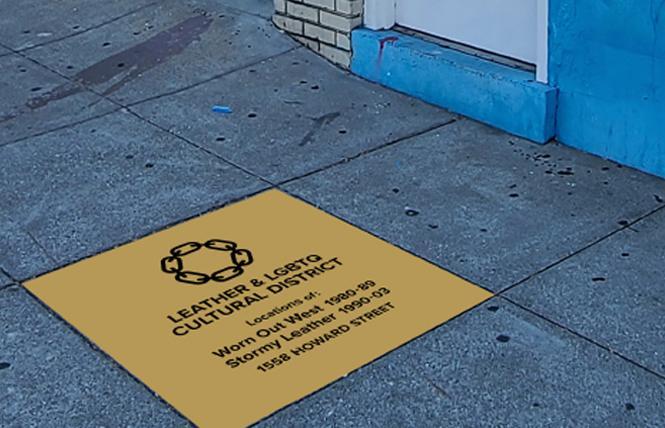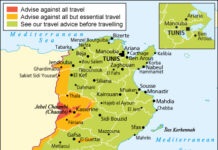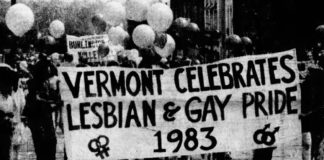A plan to commemorate 50 locations tied to San Francisco’s leather and LGBTQ culture with sidewalk markers is expected to win approval from the Board of Supervisors this week. It is timed to coincide with an underway streetscape improvement project along Folsom Street that at one point was known as the city’s “Miracle Mile.”
It earned that nickname due to the many gay bars and bathhouses that operated on or near the main artery through the South of Market district in the 1960s and 1970s. But the onset of the AIDS epidemic in the 1980s soon would diminish SOMA’s leather scene. The health crisis resulted in most gay bathhouses and sex clubs in the area closing their doors.
By the 1990s, gentrification of the neighborhood began to push out the remaining gay bars, with only a handful left in business today. Further development in the area over the last two decades led community and city leaders to designate a portion of western SOMA as the Leather & LGBTQ Cultural District in hopes of preserving it as an LGBTQ neighborhood.
Today, district leaders want to revive memories of those businesses lost to time and recognize those remaining by placing bronze plaques in the sidewalk near where they operated or currently are located. Such storied establishments as the Folsom Street Barracks, The Arena, Ramrod, The Brig, and the Club Baths of San Francisco would be memorialized with historical markers, as the Bay Area Reporter first reported in September.
With the area’s businesses devastated by the COVID pandemic, which shuttered bars and nightclubs for much of the past year, boosters of the sidewalk plaques proposal hope it will bring in an influx of visitors to the area who will support the establishments as they begin to reopen their doors due to the health crisis ebbing. LGBTQ and leather tourism has been near nonexistent over the last 12 months with the outbreak severely limiting travel and canceling the in-person parties and street fairs that catered to the fetish scene.
“This is not only appropriate from a historical perspective but of tremendous interest to tourist visitors. It will drive visitors and helps not only our culture but our economy,” said Race Bannon, the B.A.R.’s former leather columnist who is active in the SOMA leather scene and community.
Plaques would be installed in front of existing businesses such as the SF Eagle, which now fronts the new Eagle Plaza public parklet honoring the leather community built out of a portion of 12th Street at Harrison, and The End Up nightclub at the corner of Sixth and Harrison streets. One would also be located at the former home of the B.A.R at 395 Ninth Street. The weekly LGBTQ newspaper, celebrating its 50th anniversary this year, called the location home from December 1988 until October 2013.
The estimated $120,000 price tag for the plaques is coming from local developers of projects in the area who are required to pay for community improvements as part of their permit approval process. The cultural district has collaborated on the sidewalk markers with the city’s arts commission, Public Works Department, and the San Francisco Municipal Transportation Agency.
“We have had a long history in SOMA. Many of those places that are historic and led the way for our community in SOMA have gone away. We feel this will be an excellent way to commemorate those places,” said Robert Goldfarb, chair of the leather district’s board, speaking in support of the project during Monday’s meeting of the supervisors’ land use and transportation committee.
District 6 Supervisor Matt Haney, who represents SOMA, and District 9 Supervisor Hillary Ronen are the lead sponsors of the request to approve the sidewalk markers. Supervisors Aaron Peskin and Dean Preston asked to be made co-sponsors prior to voting in support along with Supervisor Connie Chan at the land use committee hearing.
All 11 supervisors will vote on the project at their meeting Tuesday, April 6, as the sponsors are seeking expedited approval since city agencies are currently constructing changes to portions of Folsom Street’s sidewalks in order to improve pedestrian safety in the area. The board is expected to approve it.
“We are working with DPW to include it in the Folsom Street redevelopment project to help offset some of those costs,” said Honey Mahogany, a queer nonbinary trans person who is the chief legislative aide for Haney, during the hearing.
The SOMA LGBTQ plaque project is similar to one undertaken several years ago by the Top of Broadway Community Benefit District in the city’s North Beach neighborhood. It has installed sidewalk markers at the site of historic businesses in the city’s Italian district, including a trio of LGBTQ nightlife spots shuttered decades ago.
A number of historic SOMA leather businesses have already been memorialized on stone plinths in the San Francisco South of Market Leather History Alley. Dedicated four years ago, the side street project spans Ringold Alley between Eighth and Ninth streets and sports bronze bootprints embedded in the sidewalk honoring various leather community leaders, some of whom owned the remembered businesses.
There has long been interest in learning about the various leather and LGBTQ establishments in SOMA. The late college professor Eric Rofes, a gay man who studied the city’s gay male culture, led popular walking tours of the neighborhood in 2005, believed to be the first such walks down SOMA’s leather memory lane.
Over the ensuing years others have created their own history walking tours and site-specific performance pieces honoring SOMA’s queer past. Once installed, the sidewalk markers will allow people to take their own journey through the neighborhood’s history.
In conjunction with the leather district plaques will be self-guided walking tours the cultural district plans to host on its website. There will be audio components in addition to write-ups about the various locations, according to Goldfarb.
As David Hyman, who is also involved with the SOMA leather district, noted for the supervisors during the committee hearing, “Many visitors who come for Leather Week and other special events ask about these places. They are not forgotten, but in most cases, they are invisible.”
A full list of the 50 SOMA locations where plaques are planned can be found in the supervisors’ resolution posted here.
Help keep the Bay Area Reporter going in these tough times. To support local, independent, LGBTQ journalism, consider becoming a BAR member.








